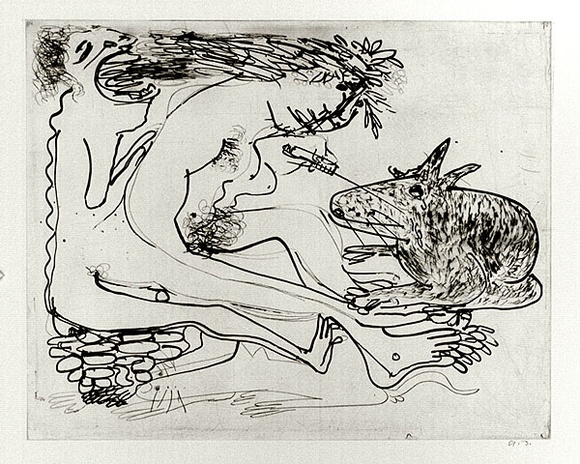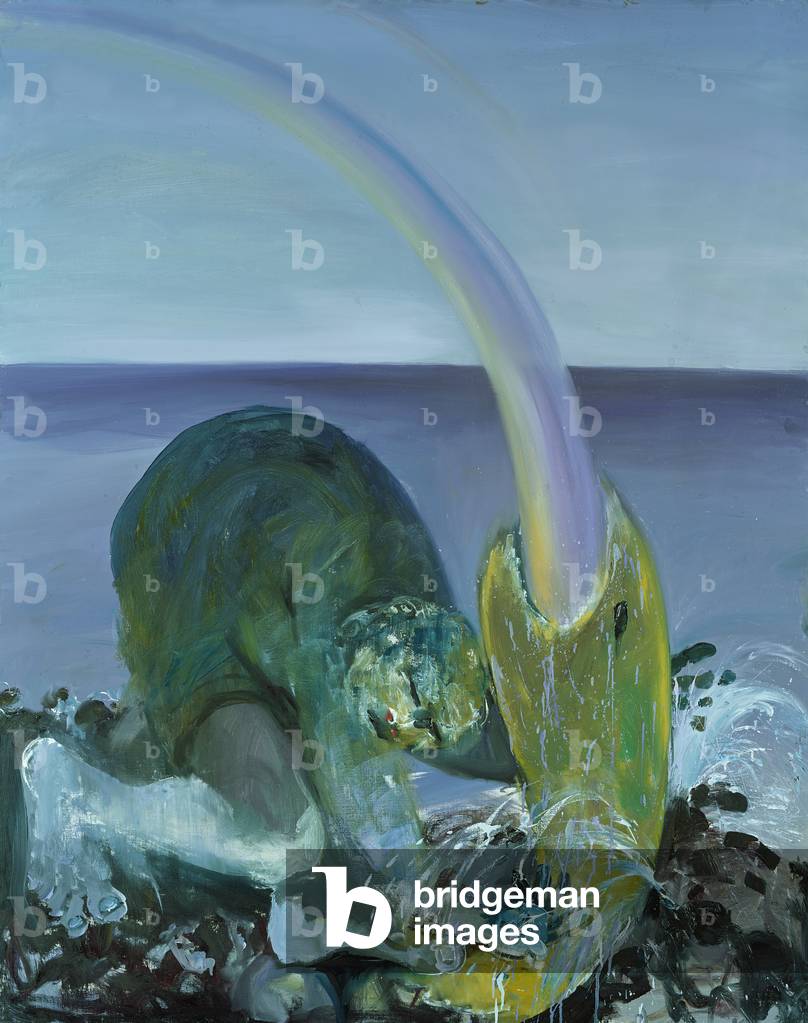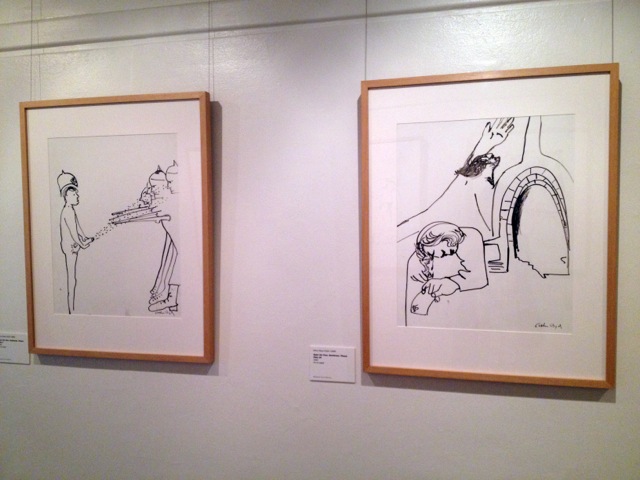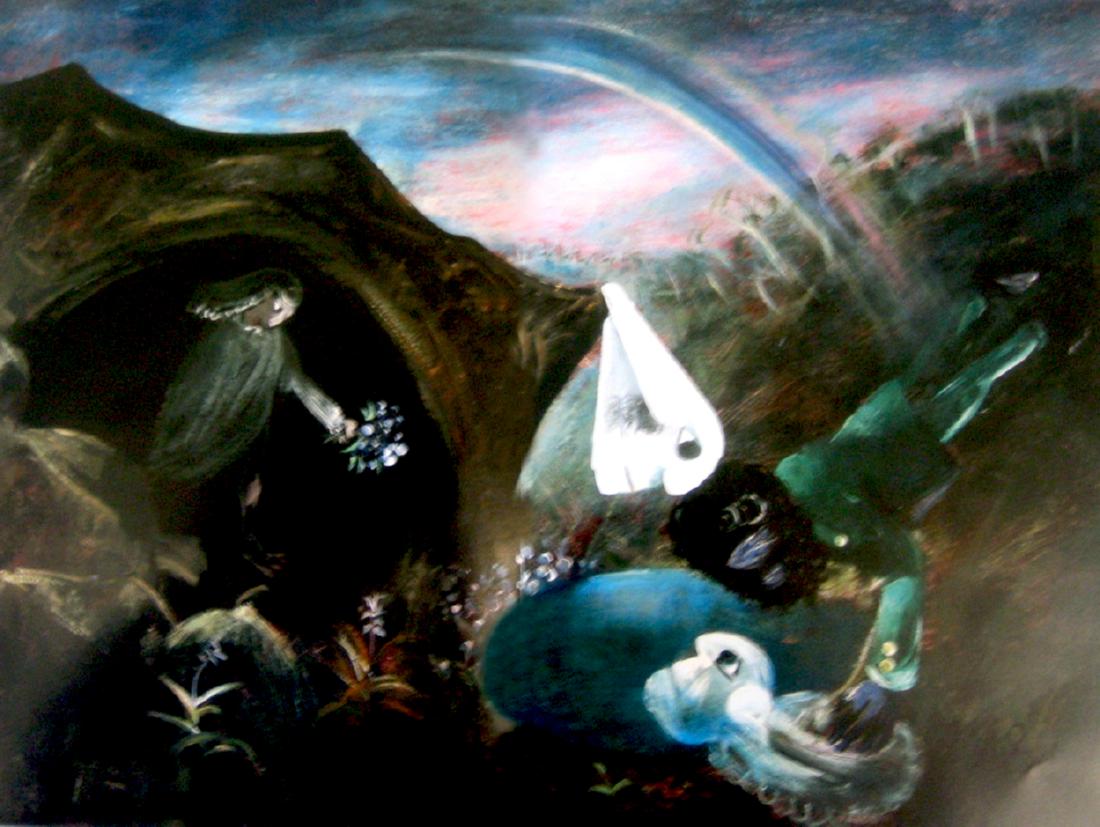Arthur Boyd: An Active Witness
The Museum of Australian Democracy at Old Parliament House
May - December, 2013
Arthur Boyd's art is generally considered political, although he never joined a political society or followed organised party politics. He was horrified by the effect of wartime conditions on society and the dark side of human behaviour. His style is inspired by Pieter Brueghel, Pablo Picasso, and Rembrandt van Rijn.
The Museum of Australian Democracy at Old Parliament House
May - December, 2013
Arthur Boyd's art is generally considered political, although he never joined a political society or followed organised party politics. He was horrified by the effect of wartime conditions on society and the dark side of human behaviour. His style is inspired by Pieter Brueghel, Pablo Picasso, and Rembrandt van Rijn.
 |
| Cripple in smoke from factory chimney |
The ink on paper drawing of Cripple in smoke from factory chimney (1942) displays the influence of Picasso's violent images with ugly features and sharp connotations of horror. This may suggest a portent of the Nazi death camps. He frequently focussed on people on crutches or in wheelchairs with dogs or other dumb animals as witnesses, metamorphosing human and animal figures. The futility and violence of war was a recurring theme, as was savagery of nature and the beauty to be found in vulnerability.
It is believed that this painting is a response to witnessing urban life during the war years, and the irrational behaviour from soldiers on South Melbourne Beach. Critics suggest there is a positive aspect, however, in the growth of life, which appears to be emerging from the feet in a poetic cyclical return.
 |
| The thirty pieces of silver |
Boyd was concerned with humankind’s culpability for treatment of others and the natural world, and he connected his experiences with subjects from literature, folklore, classical mythology and religious stories. He worked in many media including ceramics, such as for the work, Thirty pieces of silver (1950).
Bride in a Cave
|
Among other sources, Boyd raided the Bible for inspiration and found it in the tales of Nebuchadnezzar in the Book of Daniel. “He was driven from men, and did eat grass as oxen and his body was wet with the dew of Heaven till his hairs were grown like eagles’ feathers and his nails like birds’ claws." - chapter IV.
Nebuchadnezzar being struck by lightning (1968-69) is a powerful canvas of thick smears of paint – dark blues and greens with a shocking yellow explosive head (and bright red testicles like a dog).
 |
| Nebuchadnezzar in a fire |
This series was inspired by seeing self-immolation anti-Vietnam protesters (on Hampstead Heath). In Nebuchadnezzar in a fire (1969) the large canvas is full of raging colours and a skeletal howl of agony.
 |
| Red Nebuchadnezzar fallen in a forest with a lion |
Meanwhile, in Red Nebuchadnezzar fallen in a forest with a lion (1969), the figures are nebulous but you can almost hear the roar of the lion in the red and yellow swirls and streaks of paint.
 |
| Menelaus throwing down sword before Helen |
In 1970, Boyd was commissioned to create a series of etchings from Lysistrata. The gallery has six etchings from the series of twenty on display. Boyd has set the tale of women withholding sex from their menfolk in an attempt to stop the bloody conflict in a timeless period.
The white figures against a black background are like the reverse of a Greek vase, but the series was produced during the Vietnam War, so while Boyd comically illustrates Aristophanes’ witty tale, the underlying theme is the futility of war. The women take action, highlighting the price women pay in war is too high – losing husbands, lovers and sons.
 |
| Nude with rabbit and syringe |
In a vulnerable mental state and far from home, Boyd visited an animal research station in London where he saw vivisection and testing on animals. Whereas animals are often passive witnesses to human acts of atrocity in his work, the poor rabbit is the direct victim of the woman's savage needle in the etching Nude with rabbit and syringe (1968-9). Boyd suggests that the inhumanity towards animals is the result of man's monetary greed.
Large skate on a grey background
|
His concern for the environment is equally evident in Large skate on a grey background (1971) which is a departure in style if not content. The botanical depiction is real and lifelike, while the wounded flesh hints at cruelty and pain.
From 1974 Boyd began a new focus in his art, based on the Shoalhaven region around Bundanon, in New South Wales. He first visited Bundanon in 1971 whilst on a Creative Arts Fellowship at the Australian National University, Canberra, Boyd purchased his first property, Riversdale, on the Shoalhaven River near Bundanon in 1972, and the Bundanon property in 1979.
The painting of Jonah on the Shoalhaven (1976) combines elements of his artistic and environmental concerns. In the background a floating city with a mosque, and a mushroom cloud of destruction draw the eye, whereas in the foreground a figure rests against a withered tree on a white beach or perhaps salt flat, which provides very little shade with its falling leaves. The figure may be a man or a beast or a combination of both, tormented by a wound in his belly that appears to be full of gold coins. Boyd believed in the necessity for the individual to accept guilt.
From 1974 Boyd began a new focus in his art, based on the Shoalhaven region around Bundanon, in New South Wales. He first visited Bundanon in 1971 whilst on a Creative Arts Fellowship at the Australian National University, Canberra, Boyd purchased his first property, Riversdale, on the Shoalhaven River near Bundanon in 1972, and the Bundanon property in 1979.
 |
| Jonah on the Shoalhaven |
"The only way to deal with [guilt] as an artist was to paint it out of my system. To expunge my own guilt by painting it and in a way face up to it. I mean guilt in a general sense, because although I do the painting, everyone else who then looks at it is in the same position as myself. I hopefully have helped them to face their guilt also"
 |
| The Magic Fish |
In his take on the Pushkin tale, The Magic Fish (1978) depicts a blue fish vomiting a rainbow while a woman kneels before it. She could be praying to it, or throttling it, depending on which point of the narrative is reached.
 |
| Picture on the wall, Shoalhaven |
Meanwhile, Picture on the wall, Shoalhaven (1979-80) clearly indicates his environmental concerns and fear of nuclear fallout. Whilst
disinterested in organised politics, Boyd at times joined political actions. He
participated in exhibitions protesting against the Vietnam War and
commemorating the bombing of Hiroshima, and signed appeals to the Mexican
government for clemency for artist David Siqueiros.
Pre-Embarkation, Suffolk
|
Pre-Embarkation, Suffolk (1979) is a notable work. As well as incorporating his interest in the colonial past (as seen from the naked man tied to a tree, the blood on the forest floor and the black man with a broom), it is interesting stylistically. The palette of greens and cool colours reflects his ten years in Europe. While he was living in England, he received commissions to design sets for ballet and opera. This theatrical staging and the cooler environment have clearly made themselves felt on his canvas.
 |
| Hanging rocks with bathers and Mars |
Humankind’s recklessness is foretold in the burning book
observed by Mars in Hanging rocks with
bathers and Mars (1985). Both humans and gods appear detached from their environment,
guarding as well as actively despoiling a world understood as a resource.
Art
historians consider the landscape in this painting shows signs of regrowth
after fire,or perhaps a hint of military graves. They find a resemblance between the form in the distance and a
nuclear power plant located close to Boyd’s Suffolk studio in England and also
a water tower located near Bundanon. Boyd was aware of the changing character
of the Australian landscape across recorded history, prior to human impact.
 |
| Shoalhaven bathers |
 |
| Spare the face, gentlemen, please |
The exhibition concludes with some illustrations from Spare the face, gentlemen, please (1993), which illustrate the work of the same name by Tom Sanders, written in 1991. It is a collection of articles about his time in the army, living abroad, and his friendships, including reflections on the art world with all its meanness, deceit, pretensions and betrayals.
Boyd's raw and immediate artwork provides a shocking counterpoint to the written words, such as an illustration of a man shooting back at a firing squad with 'bullets' from his penis.
“You cannot say enough bad words about war. For a long time I was obsessed by war, all those dark thoughts about the individual slaughter in the First World War, people with their legs hacked off and throats cut. The war got more mechanical and more scientific and more awful."Much of Boyd's art focuses on the futility of war, yet, with similar atrocities occurring again and again, this exhibition could equally well ask the viewer to reflect upon the futility of art.








No comments:
Post a Comment